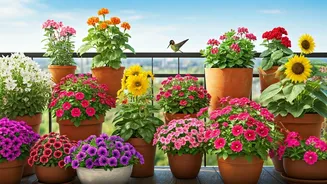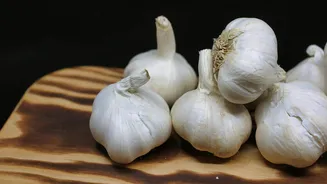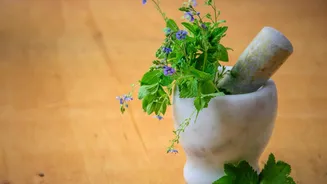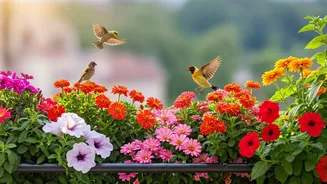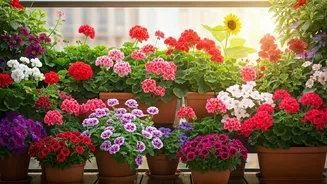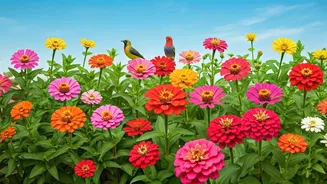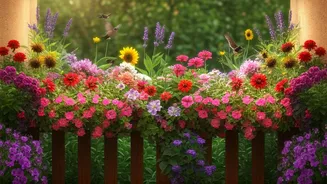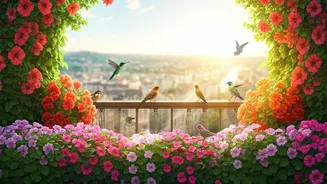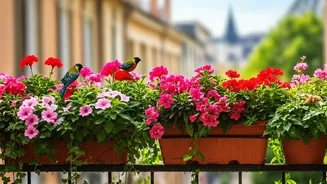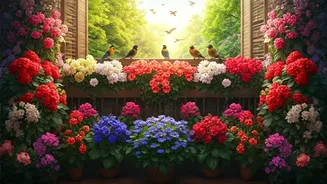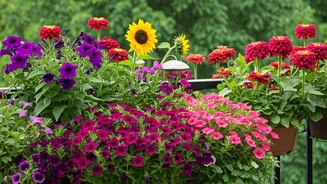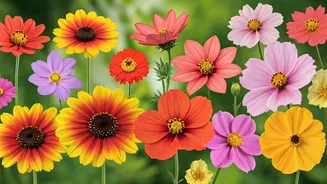Welcoming Chirpers Home
Creating a bird-friendly balcony garden enhances the beauty of your living space and offers the calming presence of birdsong. Selecting the right flowers
is key to attracting a variety of bird species. The flowers detailed in this article are specifically chosen for their attractiveness to birds and their suitability for balcony gardens. By incorporating these plants, you can provide food, shelter, and a welcoming environment for your feathered friends. Consider the light exposure, soil conditions, and available space on your balcony when selecting these flowers, ensuring that your chosen blooms will thrive. Remember to avoid pesticides and other harmful chemicals to create a truly safe and nurturing habitat for the birds you hope to attract. Moreover, creating a bird bath or shallow dish with water on your balcony can further increase your balcony’s attractiveness for birds.
Marigolds: Sunny Charmers
Marigolds, with their vibrant yellow, orange, and red hues, are a popular choice for any garden. These easy-to-grow annuals are attractive to birds because they provide seeds that serve as a valuable food source. Marigolds prefer full sun and well-drained soil, making them suitable for most balconies. They are also known for their ability to deter certain pests, offering a dual benefit. Plant marigolds from seed or purchase young plants; they generally flower throughout the warmer months. Regular deadheading (removing faded flowers) promotes continuous blooming and encourages the production of more seeds. Consider placing marigolds in pots or containers where they can receive at least six hours of sunlight daily for optimal growth and bird attraction. The bright colors of marigolds not only attract birds but also add visual appeal to the balcony.
Sunflowers: Towering Treats
Sunflowers, with their towering heights and cheerful faces, offer a substantial food source for birds, especially as they mature and their seeds ripen. These plants require a good amount of sunlight and space, so they might be best suited for larger balconies or those with ample sun exposure. Plant sunflower seeds directly in the pot, providing sufficient room for the plant to grow. Sunflowers attract a variety of birds, including finches, sparrows, and other seed-loving species. As the sunflower head matures and the seeds begin to dry, you can allow the birds to access them naturally, providing a delightful spectacle. Be prepared for the sunflower to grow tall, so select a sturdy pot and consider providing support if necessary to prevent the plant from toppling over in strong winds.
Petunias: Colorful Cascades
Petunias, available in a wide spectrum of colors, are ideal for adding beauty to hanging baskets or containers on balconies. While primarily ornamental, their vibrant blooms can attract hummingbirds and, indirectly, other insects that birds may feed on. Petunias flourish in full sun to partial shade and require regular watering and fertilization to encourage continuous blooming. Choose cascading varieties for hanging baskets to create a visually appealing display, or select compact varieties for pots on railings or shelves. Deadheading spent flowers is crucial to promote further blooming. Petunias are versatile and easy to care for, contributing both aesthetic value and potential benefits to attracting birds through the insects they attract, like pollinators.
Lantana: Butterfly Magnet
Lantana is renowned for attracting butterflies, which in turn can attract birds that feed on insects. These plants offer a long blooming season and come in a variety of colors, adding a cheerful touch to any balcony. Lantana thrives in full sun and well-drained soil, tolerating drought conditions once established. They can be grown in pots or containers and require regular pruning to maintain their shape and encourage more blooms. The dense clusters of tiny flowers are a favorite among pollinators, creating a lively environment. Ensure lantana is planted in a location where it receives at least six hours of sunlight each day. Proper care and maintenance will result in a plant that flourishes, providing a source of sustenance for both insects and the birds that may visit.
Zinnias: Bold Blooms
Zinnias, with their bright, daisy-like flowers, are a favorite among both gardeners and birds. They offer a range of colors and bloom throughout the summer. Zinnias attract butterflies and hummingbirds, which helps draw in other insect-eating birds. Plant zinnia seeds directly in pots or containers; they prefer full sun and well-drained soil. Regular deadheading is essential for encouraging continuous blooming and seed production. Zinnias are easy to grow and add a vibrant, cheerful touch to any balcony garden, making them a great option for those looking to create a welcoming habitat for birds. Plant a mix of zinnia varieties to provide a greater variety of color and attract a wider range of birds to your balcony.
Nasturtiums: Edible Delights
Nasturtiums are not only beautiful with their vibrant flowers and unique, round leaves, but they are also edible and can attract birds. They attract aphids, which in turn can attract birds that feed on insects. Nasturtiums prefer full sun to partial shade and well-drained soil. They are relatively easy to grow and can be grown in pots, hanging baskets, or even allowed to spill over the sides of containers. Nasturtiums self-seed easily, so you might find new plants sprouting up each year. The flowers and leaves can be added to salads or used as a garnish. Their unique aesthetic and dual benefits make nasturtiums a great choice for a balcony garden.
Coneflowers: Purple Pops
Coneflowers, also known as Echinacea, are native wildflowers known for their resilience and attractiveness to birds. Their cone-shaped blooms come in a range of colors, and the seeds that form after flowering are a valuable food source for birds, particularly finches. Coneflowers thrive in full sun and well-drained soil and are drought-tolerant once established. These perennials will return year after year, providing continuous beauty and sustenance for visiting birds. Plant them in pots, ensuring they receive plenty of sunlight. Deadheading spent flowers helps to promote more blooms and seed production. Coneflowers are a great choice for attracting birds, adding a touch of natural beauty to your balcony.
Cosmos: Delicate Charms
Cosmos flowers offer a delicate charm with their daisy-like appearance and vibrant colors. They attract butterflies and other pollinators, creating an appealing environment for insect-eating birds. Cosmos grow well in full sun and well-drained soil, and they are relatively low-maintenance. They can be planted from seeds or young plants. Cosmos bloom throughout the summer and fall, providing continuous color and attracting birds with the insects they attract. Plant them in pots on your balcony, and you'll soon see a flutter of activity. Deadheading spent flowers will encourage more blooms and extend the flowering season. Choose a variety of cosmos to add a mix of color and texture to your balcony garden.
Salvia: Hummingbird Favorites
Salvia varieties, especially those with bright red flowers, are known for attracting hummingbirds, which in turn can attract insect-eating birds. Salvia thrives in full sun and well-drained soil and comes in various forms, including annuals and perennials. Plant them in pots, and they’ll flower throughout the growing season. Regular watering and deadheading help to encourage more blooms. The vibrant colors of salvia and their attractive properties for hummingbirds make them a wonderful choice for attracting birds to your balcony. Planting several types of salvia can provide even more interest and attract a wider range of pollinators and, by extension, birds. Consider different varieties to enjoy a beautiful display and support the local bird population.
